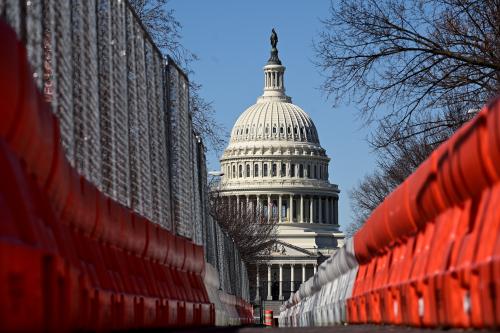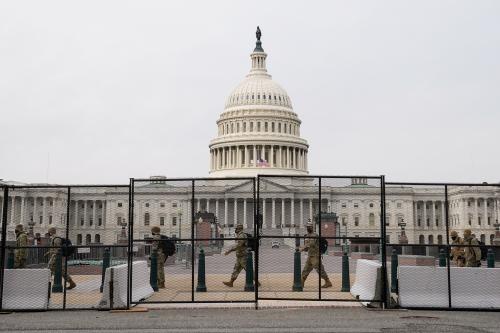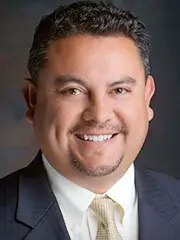On January 6, 2021, a violent mob of President Donald Trump’s political supporters gathered at the White House, and after hearing speeches from President Trump and his allies, marched down Pennsylvania Avenue and committed an act of domestic terrorism against the U.S. Capitol. These political supporters who included known members and leaders of right-wing extremist and/or domestic terrorist organizations assaulted police, broke into the Capitol—including the Senate Chamber—and made violent threats against Vice President Mike Pence, House Speaker Nancy Pelosi, and others, while a gallows was erected out front.
This despicable display of violence was a dark moment in our nation’s history, but we must not think of it as a singular event. It was a public display of an ongoing threat from violent, extremist, domestic terrorists who seek—as they did on January 6—to dismantle the institutions of American government with which they disagree. Several of the January 6 insurrectionists who have been charged with crimes have claimed that they were just following President Trump’s orders that day, fueling a feeling of belonging and righteousness among the ranks. Their sense of sustained faux virtue has been reinforced by Republican members of Congress who question the 2020 election and embrace conspiracy theories like QAnon. It is echoed by right-wing media who devoted more outrage to an athlete kneeling during the national anthem than an anti-democratic, extra-judicial, anti-American insurrection. This threat to the American Republic did not end on January 6, it was emboldened by it, and the institutions of government must continue to search for ways to protect itself.
In recognizing the one-year mark since the January 6 insurrection, scholars across Brookings have contributed short entries in this post. They discuss what has happened in the year since the attack, what we have learned as a nation since then, and what we must consider in the years ahead.
 A dangerous era in American politics
A dangerous era in American politics
William G. Gale — The Arjay and Frances Fearing Miller Chair in Federal Economic Policy and a Senior Fellow in the Economics Studies program; Darrell M. West — The Douglas Dillon Chair in Governmental Studies and Vice President/Director of the Governance Studies program: The January 6 insurrection signaled the rise of a dangerous new period in American politics. Armed intruders broke into the Capitol building, assaulted law enforcement officers, and temporarily stopped Congressional certification of Joe Biden’s 2020 victory. Those events coincide with other worrisome U.S. developments: legal changes that make it easier for people to take their guns anywhere without reporting it or having a license, increased incidences of book prohibitions and public book burnings, talk of state secession, banning of the teaching of Critical Race Theory, continuing claims of election fraud in the absence of any evidence, and historic efforts to restrict the voting rights of racial and ethnic minorities.
These activities could be unassociated actions that happen to have occurred over the past year or the sign of a new era that should worry U.S. observers. We believe the latter is the more likely interpretation because the factors that are driving these aggressive actions indicate deeper maladies that are becoming hard to ignore. These include conservative whites who fear losing their privileged social and cultural status and poorly educated people who have seen their relative economic status decline over the past 50 years. The combination of cultural and economic anxieties fuels a tribal politics that bodes poorly for the future. Unless we can defuse current conflict and address underlying issues, this tinder box could explode and engulf the country in mass violence and social unrest.

Polarization and right-wing radicalization endure
Vanda Felbab-Brown — Senior Fellow in the Foreign Policy program’s Center for Security, Strategy, and Technology: The Biden administration and the Democratic-led Congress have taken important steps to begin addressing the radical right’s threat to U.S. democracy which mushroomed during the Trump administration—but the deep-seated, dangerous, and insidious threats of radicalization and profound political polarization remain.
The Biden administration released a strategy for countering domestic terrorism and along with the U.S. Congress, launched investigations into the January 6 insurrection, seeking to prosecute its perpetrators. Various federal agencies adopted other response measures—the Departments of Defense and Veterans Affairs unveiled policies to address and prevent the radicalization of members of the military and veterans, and to assist in their re-integration into civilian life.
But these efforts to uphold the nation’s basic unity, public safety, and rule of law have been rejected by many Republican politicians who still gravitate toward rejectionist fringe politics. Republican politicians who condemned the insurrection, even with impeccable conservative credentials like Liz Cheney, were shunned by the Republican Party or decided not to run again.
Even less has been done to counter radicalization at the local political level, where right-wing militias, politicians and the police have problematically mixed for decades.
This dangerous polarization translates into everyday life. It can be seen in the acceptance or rejection of COVID vaccinations and mask-wearing on the basis of politics instead of facts and science. Such outcomes interfere with the health and survival of fellow U.S. citizens and has tempted U.S. adversaries to dangerously exploit the country’s political rifts.
Healing this polarization requires an explicit choice by both Democratic and Republican Party politicians to promote bipartisanship on fundamental issues including the rule of law, the U.S. Constitution, public health, internal safety, and national security. This in turn necessitates that politicians who don’t embrace the rule of law and who reject violence in politics do not get (re)elected.

Is the democratic experiment over?
Rashawn Ray — Senior Fellow in the Governance Studies program: Images and videos from the Capitol riot showed a deliberate attempt to overthrow the democracy of the United States. Five people associated with the insurgency ultimately died and roughly 140 police officers were injured. While over 700 individuals have been charged with crimes (including people with links to white nationalists groups, the military, and law enforcement), it is America’s social institutions that have failed the public. The insurgency was an act of domestic terrorism, and the democratic experiment of liberty, justice, and equality seems to be forever fractured.
Political polarization in Congress, media, and the public is at an all-time high. The polarization is not only about who is complicit in the insurgency, but why it occurred. Though participants stated they were protesting the election results, their rhetoric, attire, and behavior (including hanging a noose, waving a confederate flag, and wearing an Auschwitz Concentration Camp shirt) suggest the insurgency was very much about “maintaining and enacting white supremacy.” Some elected officials (including recently elected riot participants) have aimed to trivialize the riot and block an investigation into the insurgency. Despite controlling the presidency and Congress, Democrats have yet to pass meaningful legislation to address voting rights and police brutality. Collectively, Americans, regardless of political orientation, feel that democracy is failing them. It is clear that America needs to evolve into a truly equitable democracy or potentially face an ultimate demise.

The people under siege
Molly E. Reynolds — Senior Fellow in the Governance Studies program: The insurrection at the U.S. Capitol on January 6, 2021 sought to disrupt the peaceful transfer of power—and, by extension, represented an attack on one of the building blocks of our democracy. But for tens of thousands of elected members of Congress, staffers, reporters, and individuals who perform the unheralded work of making the Capitol run every day, it represented something else as well—an attack on their workplace.
Much of the focus on accountability for January 6 has focused on questions of who was involved in instigating the riot—indeed, this has been the primary public-facing task of the House Select Committee on the January 6 Attack on the United States Capitol. But lower profile work to ensure that the Capitol is a safe place to work is equally important. Congressional committees continue to oversee efforts to reform the Capitol Police and President Biden recently signed legislation making it easier for the National Guard to assist in the event of an emergency on Capitol Hill. More generally, the House Select Committee on the Modernization of Congress continues to advance recommendations to improve the ability of congressional staff to serve the American people.
Ultimately, however, deep challenges remain. In addition to ongoing physical security concerns, racism and prejudice abound on the Hill in public and less public settings. Congress can’t do the work of the country without its staff of all kinds—and employees can’t realize their full potential if they don’t feel safe and valued at work.

Liz Cheney’s ‘Profile in Courage’
Elaine Kamarck — Senior Fellow in the Governance Studies program and Founding Director of the program’s Center for Effective Public Management: Unlike other Republican leaders who initially condemned the attacks on Capitol Hill only to retreat and/or equivocate after a tongue lashing from former President Trump, Representative Liz Cheney (R-Wyo.) has staked out a clear and unambiguous stance. If the young John F. Kennedy were around today writing his book “Profiles in Courage,” there is no doubt that Cheney would have a starring role. Last spring, she wrote in The Washington Post, “We Republicans need to stand for genuinely conservative principles, and steer away from the dangerous and anti-democratic Trump cult of personality… I am committed to doing that no matter what the short-term consequences might be.”
Notice the words “short-term.” In the short term, she has been ousted from her leadership role in the House Republican Conference, and she has gained an opponent in the Republican primary who Trump handpicked. But in the long term, she has established herself as the absolute leader of that portion of the Republican Party that would like to see Trump gone. On January 2 of this year, Cheney put it as plainly as she could on “Face the Nation,” “…the single most important thing, though, is to ensure that — that Donald Trump is not the Republican nominee, and that he certainly is not anywhere close to the Oval Office ever again.”
Cheney has boldly staked out leadership of the post-Trump Republican Party. She’s a real conservative—Democrats who like her opposition to Trump will almost never like her policy positions. Breaking with your party is a bold move, and in an electorate that has a reflexive distaste for political parties, it can mark an official as independent and strong. Bill Clinton broke from Democratic Party orthodoxy in 1992 by forming the “New Democrats” and became president for two terms.
Liz Cheney has positioned herself to do the same in her party.

Without changes, the chance of a repeat of January 6 is high
William A. Galston — The Ezra K. Zilkha Chair and a Senior Fellow in the Governance Studies program: A year after a mob failed to subvert Joe Biden’s election, the country has made no progress toward making its democracy more secure.
On the legal front, the threat to the electoral system has not abated, and in some respects, it has intensified. In many Republican-controlled states, legislatures have moved to reduce the authority of secretaries of state and other state and local officials charged with overseeing and certifying the vote count. A few legislatures are asserting their alleged authority to set aside the popular vote and select their own slates of electors, and talented lawyers are sharpening their arguments that the U.S. Constitution gives legislatures the ultimate power to make this determination.
Equally threatening is the failure of Congress to reform the Electoral Count Act of 1887, adopted in response to the contested presidential election of 1876, in which contested slates of electors from three states created a deadlock in the Electoral College. Contemporary legal analysts believe that the ECA is doubly flawed: vague at key points and exposed to serious constitutional challenge if used to resolve the next contested presidential election.
Equally troubling, public opinion has not budged over the past year. A strong majority of Republicans continue to believe that Joe Biden was not elected to the presidency—47% describe the Jan. 6 assault as an act of patriotism, and 56% believe that the attackers were “defending freedom.” A recent survey found that one-third of Americans, including 23% of Democrats and 40% of Republicans, believe that violence against the government is justified in some circumstances. In 1995, just one-tenth of Americans held this belief; in 2010, one-fifth.
Another contested presidential election could deal a fatal blow to constitutional democracy.

Public deeply divided about the 2020 insurrection
Gabriel R. Sanchez — David M. Rubenstein Fellow in the Governance Studies program: The 2020 Collaborative Multiracial Post-Election Survey, a large (n=20,000) and diverse national survey, provides perspective on how the public reacted to the January 6 insurrection. The study finds that attitudes about the insurrection were evenly divided across the population, but varied significantly by race.
Just over half (53%) of Americans felt that the events on January 6, 2021 were a “coordinated act of insurrection”, the other 47% believed it was mostly a “protest that went too far”. African Americans however were much more likely (67%) to believe the attack on the U.S. Capitol was an act of insurrection compared to white Americans (45%), Latinos (50%) and Asian Americans (52%).
The public is similarly divided on the role of Congress in the insurrection. A slim majority (53%) of respondents felt that Republican members of Congress were undermining democracy with their efforts to stop Biden’s victory, compared to 21% who believed they were protecting democracy, and 26% who were not sure. African Americans were again more likely than other racial groups to believe that these actions were intended to undermine democracy (63% compared to 43% among whites and 52% among Latinos).
The 2020 CMPS also asked respondents about police brutality, a catalyst for protest activities in 2020. Only 36% of respondents believe that democracy can protect them from police mistreatment, including 31% of African American respondents.
As we reflect on where we stand a year after living through one of the most significant challenges to American democracy in our nation’s history, it is important to recognize that we are a nation divided in how we reacted to this day of infamy. The significant gap in Black and white views about the insurrection, coupled with the low percentages of people of color who have faith that democracy will ensure they are treated fairly by police, makes clear that there is work needed to allow us to move past this together as a nation.














Commentary
Around the Halls: One year since the January 6 insurrection
January 5, 2022